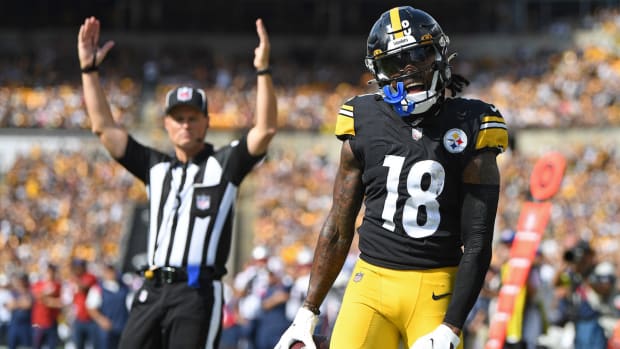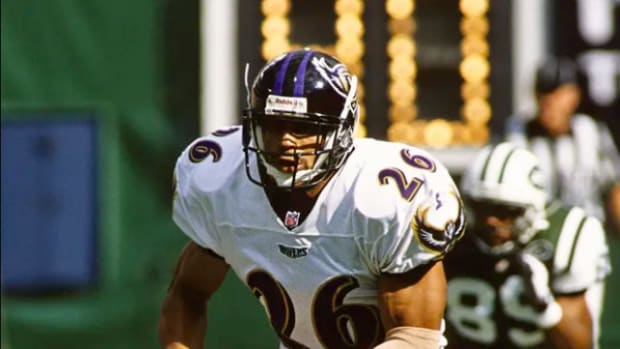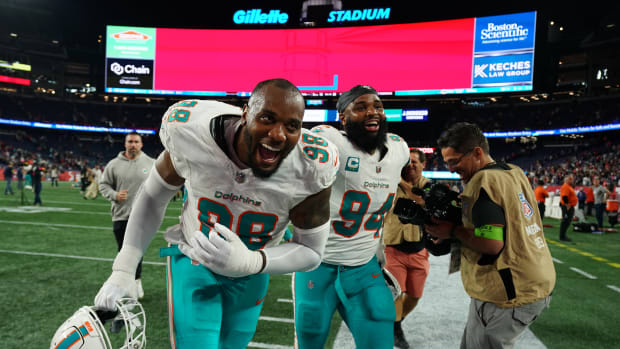Wait to Draft a Fantasy QB and Then Go After These Five Targets
It has become a common strategy to wait on drafting a quarterback in fantasy football. This is especially true in a high-stakes format such as the Fantasy Football World Championships (FFWC).
There are good reasons not to pay a premium for quarterbacks. If you look at the top finishers in the overall FFWC contests, most of them waited on the quarterback position. Quarterbacks score the most points, and the goal isn't to ignore the position, but we should seek the value that falls in the middle to late rounds of the draft.
You can only start one quarterback and passing touchdowns count for four points (in most league formats). On the flip side, you can start multiple running backs and wide receivers. The talent drop-off at the skill positions is way more significant than at the quarterback position. A lot of quarterbacks in the QB4-QB19 range aren't separated by many points. For quarterbacks that played at least 10 games in 2018, Andrew Luck was QB4 in points per game with an average of 24.4 and Josh Allen was QB19 with 20.4 points per game. Aaron Rodgers was QB9 with 22.8 points per game, while Baker Mayfield was QB18 in points per game with 21.2. The difference is quite small.
The problem with taking a quarterback in the first few rounds is the opportunity cost. By taking a quarterback early, you are passing on a potential breakout player at running back or wide receiver. Then you are stuck watching other teams get good value at the position later in drafts. (That’s especially true in the FFWC where a starting lineup consists of one quarterback, two running backs, three wide receivers, one tight end, two flex spots, and of course the kicker and defense. That extra flex spot pushes quarterbacks further down the board compared to most leagues.)
But Patrick Mahomes won people championships last year, right? Sure, he helped many teams, but he was drafted as a backup quarterback in most leagues and had one of the best seasons ever with 5,097 yards and 50 touchdowns.
If you want Mahomes this season, the Average Draft Position (ADP) is 51 in the FFWC. Of course, he's going to regress, and that could still mean a 40-touchdown season in a loaded offense, but the cost is high. If he falls back to the pack, it's a bad pick. While Mahomes might seem like good value in the fifth round, Deshaun Watson, the second quarterback off the board, has an ADP of 83. Those seem like overpays when Carson Wentz (ADP 127), Cam Newton (ADP 142) and Russell Wilson (144 ADP) go way later.
There are always quarterbacks taken late in drafts that turn into a top-10 players at their position. Mahomes (30.3 points per game), Matt Ryan (26.3), Ben Roethlisberger (25.8) and Jared Goff (23.7) are a few examples from last season.
The rule changes in the NFL over the last few seasons have benefited the offense, and more points are being scored. Teams are becoming more creative and relying more on the pass. There were 12 quarterbacks that passed for 4,000-plus yards last season. There were six in 2008.
Discipline is needed when attacking the quarterback position. There may be teams that take two quarterbacks before some take their first. Don't panic if it happens. Knowing the ADPs and reviewing the draft boards will show there are still plenty of quality options to choose from even if you wait until Round 12.
Here are five quarterbacks going late to consider. If you're wondering why Kyler Murray isn't here it's because he's not cheap. His ADP is 116, so if you believe in him, beware you need to act early. But here are five going even later.
Jameis Winston, Tampa Bay Buccaneers (ADP 149)
The setup is ideal for Winston to have success in fantasy football. The Buccaneers’ defense is awful, the running game has question marks and they will trail often, which means the team will be forced to lean on the passing game. Winston tends to be aggressive, and it can lead to turnovers. Bruce Arians takes over as the head coach, and he likes to throw the ball downfield. Winston was second in Average Depth of Target (aDOT) the last two seasons. The Buccaneers have three excellent targets with Mike Evans, Chris Godwin and O.J. Howard. Winston was in and out of the starting lineup last season, but when he played, he finished as a top-10 QB in points per game.
Lamar Jackson, Baltimore Ravens (ADP 192)
Quarterbacks that run the football are going to pose a high floor. These types of quarterbacks don't need to do much in the passing game and can still be a useful fantasy starter each week. Cam Newton is one of the prime examples. The Panthers’ quarterback hasn't passed for 4,000 yards since his rookie season and has topped 24 touchdown passes once in eight seasons, but has averaged 39.1 yards rushing per game and scored 58 rushing touchdowns in 123 career games. The knock against Jackson is the lack of prowess as a passer, but he has improved each season, dating back to his time at Louisville. As a starter last season, Jackson averaged 163.5 passing yards, 76.2 rushing yards and 1.3 total touchdowns. From Week 11 until the end of the season, Jackson had 119 rushing attempts for 556 yards with four touchdowns. It's difficult to ask a quarterback to run that often since it increases the risk of injury, but if Jackson can show slight improvements as a passer, he will be a QB1 and a great value.
Dak Prescott, Dallas Cowboys (ADP 193)
Few people are excited to take Prescott, and many are surprised when they find out how well he has fared over his first three seasons. Prescott has been a QB1 in each of his first three seasons and has also rushed for six touchdowns every year. The Cowboys gave Prescott one of the worst wide receiving groups in the NFL going into last season. It all changed once they acquired wide receiver Amari Cooper from the Raiders. Prescott had a 62.1 completion percentage, 6.88 yards per attempt and 202.4 yards per game in seven games without Cooper in 2018. With Cooper, including the playoffs, Prescott had a 70.1 completion percentage, 7.69 yards per attempt and 269.1 yards per game. His touchdown percentage increased from 3.9% to 4.2%, and the interception rate decreased from 1.9% to 1.3%. Prescott was the QB4 in fantasy with Cooper.
Mitchell Trubisky, Chicago Bears (ADP 174)
Trubisky was one of the top quarterbacks last season before a shoulder injury caused him to miss two games and struggle down the stretch. He showed a high ceiling, but a low floor as 16 of his 27 touchdowns came in four games. The aspect that makes Trubisky appealing is the ability to run. He rushed for 421 yards on 68 attempts with three touchdowns. Some of the opportunities for Trubisky were limited since the Bears’ defense was dominant. It will likely change this season with the departure of Vic Fangio, and the defense is unlikely to have the high turnover rate continue from last season. The Bears’ offense has a noteworthy offensive line and a plethora of weapons with Allen Robinson, Anthony Miller, Trey Burton and Tarik Cohen. Not to mention, we don’t know what rookie running back David Montgomery will do, but we do know that he will draw opposing defenses’ focus, which could open up the passing game for Trubisky.
Jimmy Garoppolo, San Francisco 49ers (ADP 238)
If you need proof of how deep the quarterback position is, then Garoppolo is a good example. He was being selected as a QB1 in drafts last season and tore his ACL in Week 3. He missed the rest of the season. That's not enough of a sample to judge whether he's good or not, yet now he's often being drafted outside the top 20 quarterbacks. Kyle Shanahan got a lot out of the offense with backup quarterbacks, and the team added Deebo Samuel, Jalen Hurd and Tevin Coleman to go along with George Kittle, Matt Breida and Dante Pettis. The 49ers quarterback has averaged 282.5 passing yards, and 1.63 touchdown passes per game in his eight games with San Francisco.




































